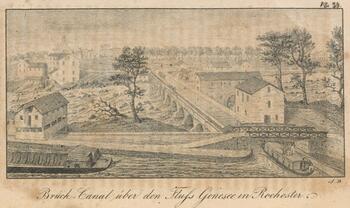The French Revolution in 1792, along with the Federalist anti-alien policies, created a sharp decline in immigration to America. But following Napoleon’s defeat, the subsequent turmoil in Europe and the installation of a more tolerant administration in Washington, DC caused immigrants to once again stream into America. The Erie Canal was both a source of work for immigrants as well as a passage to western lands.
Many of the immigrants coming to the country were peasants with few skills, and a number became part of the massive labor force required to construct the Erie Canal. Other travelers from both Europe and from the east coast of the United States were farmers seeking fertile lands out west. The amazingly low cost of transportation by Canal inspired families, and sometimes entire communities, to travel west for cheap land. As early as 1825, just after the opening of the Canal, about three hundred passengers per week were arriving in Detroit via passage from the Canal to the Great Lakes. The total population of Ohio, Indiana, Illinois, and Michigan grew from about 800,000 in 1820 to over four million in 1880.
This document is a receipt for the payment of passage on the Erie Canal for five people, purchased in Albany, New York in 1837. The cost of passage described as "2 over and 3 under" may pertain to age or to whether or not they were sleeping below in the cabin or on deck. Courtesy of The Erie Canal Museum via Central New York Library Resources Council and Empire State Digital Network.
This illustration of the Erie Canal at Rochester is from a German book by A. Duttenhofer published in 1835. The title in English is Tour of the United States of North America, with special reference to the Erie Canal. Courtesy of The New York Public Library.

